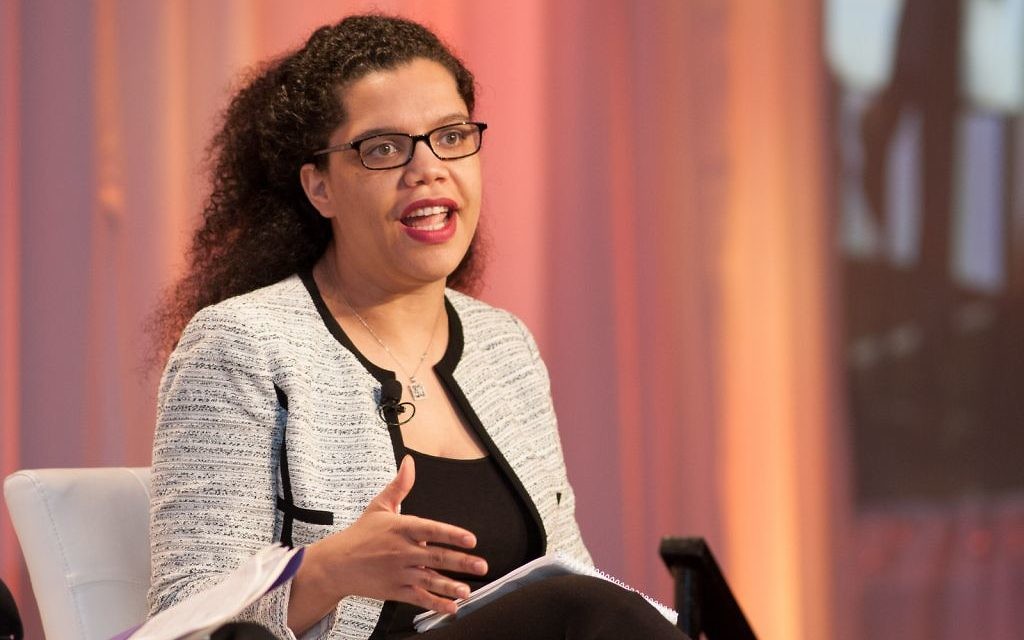Jews of Color Expose Racial Rifts
A racialized Jewish experience is a common theme among panelists at a Jewish Funders Network session.

Four women sat among a circle of people eager to hear their stories.April Baskin, Danielle Natelson, Nadiya Boyce-Rosen and Jamie Maxner shared their experiences of being Jewish women of color. As they talked and dissected their identities, it was apparent the common thread in their narratives was overcoming the adversity of being a minority within a minority.
The group of predominantly Ashkenazi Jews joined the quartet for the “Engaging Race and Racism: Not Finish, but Also Not to Desist” session March 21 during the Jewish Funders Network conference. The audience listened in disbelief as each woman told a similar story.
“My life has been punctuated by racism no amount of excellence could protect my family from,” said Baskin, the vice president of audacious hospitality at the Union for Reform Judaism. “I’ve had a very racialized experience in the U.S. I’ve been called a monkey, accused of cheating on tests and told my nose was slammed in a door.”
Get The AJT Newsletter by email and never miss our top stories Free Sign Up
The women of color at times have been scrutinized within the Jewish community. Confronted with uncomfortable questions about their Jewishness, the women recalled moments of disruption regarding their racial identity.
Maxner, who is half-Chinese and half-Ashkenazi, was rejected from numerous day schools before she was accepted into one in Greenwich, Conn. That was the beginning of her racialized Jewish experience. Though her parents worked hard to shelter her from discrimination, she was inevitably bombarded with it at a young age.
“I was called out at the age of 6 when a friend’s brother asked me why I look different,” said Maxner, who is on the advisory board of Repair the World. “That’s when I realized this is a thing I have to understand. This is a thing I have to answer for.”
Acknowledging being a Jew of color is a source of empowerment for many. Natelson said that naming can change the narrative and provide a deeper meaning to existence.
“There is tremendous power in naming yourself. When you’re talking about racial justice, you’re talking about a visibility issue,” she said. “When I name myself, I step into that term. It also signals to other Jews of color it’s safe to be here.”
Racism is antithetical to Judaism, going against the tenets of the Torah, Baskin said. She said it’s a historical fact that Jews of color have always been part of the community.
“We need to shift the thinking. We’re a Jewish global people. We’ve long been multiracial,” Baskin said. “Most people in the Torah were black and brown people, and it doesn’t take away from the richness of Judaism.”
But when the identity of a Jew of color is used to dehumanize or characterize someone as “the other,” it changes the conversation, said Natelson, the Simha and Sara Lanier director of Jewish learning and leadership for Hillel at UCLA.
Though she grew up with a mainstream Jewish lifestyle, she was often questioned about her ethnicity after she left for college. “I would always get the politically correct question ‘Which one of your parents is Jewish?’ and I would say, ‘Both of them, so what’s your question?’ ”
Even among non-Jewish blacks, Natelson wasn’t necessarily welcomed. “I met it with anger and disengagement and decided if they don’t want me here, I’ll go to my Jewish community. They may say messed-up stuff sometimes, but those are my people.”
The best thing is to not look at any community as binary, said Boyce-Rosen, the community disabilities assistant at the Greater Atlanta Jewish Abilities Alliance. Boyce-Rosen is a black Jew who married a Sephardic Spanish Jew.
She said the black and Jewish communities are not homogeneous.
“Sometimes there isn’t an understanding of spectrum, blackness on a spectrum or Jewishness on a spectrum,” she said. “The black community isn’t immune to being anti-Semitic, and the Jewish community isn’t immune to racism.”
The best way to face racism within the Jewish community is through inclusion. Opening spaces for dialogue is essential, Natelson said. She also put an emphasis on actively including Jews of color to build diverse communities.
“The Jewish world has talked about inclusion, but race has not been a part of that conversation,” Natelson said. “If a community wants to be welcoming to Jews of color, make them a part of the conversation … and not just a token Jew of color. Go seek them out.”




comments